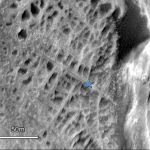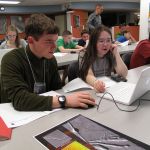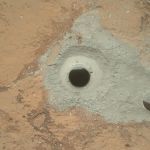Published on: July 30th, 2014
Retired Teacher Still Inspiring Students Through MSIP
Retirement is a time to sit back, relax and enjoy life. For educators it’s a time to reflect upon a long and sometimes challenging career of inspiring young minds in the classroom. Retirement is their time to finally relax and get away from those wild kids. But that is not exactly how Jeff Collins is spending his retirement. He is still teaching students through NASA’s Mars Student Imaging Program at Arizona State University.
After 35 years in the classroom Jeff Collins, a retired teacher from Mercury Mine Elementary School is leading... Read More
Published on: March 17th, 2014
 Evergreen Middle School – Cottonwood, CA
7th grade students at Evergreen Middle School reached for the stars with two service-learning projects. Their student-led NASA Research Team members and teachers are passionate about studying Mars. In 2010, the school received national attention for discovering a new cave by closely examining images of the planet’s surface. Last year, they looked at sites ideal for establishing a human presence on the surface of the Red Planet.
To support their work on the... Read More
Evergreen Middle School – Cottonwood, CA
7th grade students at Evergreen Middle School reached for the stars with two service-learning projects. Their student-led NASA Research Team members and teachers are passionate about studying Mars. In 2010, the school received national attention for discovering a new cave by closely examining images of the planet’s surface. Last year, they looked at sites ideal for establishing a human presence on the surface of the Red Planet.
To support their work on the... Read More
Published on: October 25th, 2013
Coaching a Winning MSIP Team in Rural California
How can we motivate middle school students to pursue careers in Science, Technology, Engineering and Math (STEM)? Our most recent teacher spotlight focuses in on Dennis Mitchell at Evergreen Middle School in northern California and he may have a fairly unique approach to answering that question, “no grades”.
“The Mars Student Imaging Project is the single most satisfying curriculum and experience I have ever done with students,” said Mitchell.
Dennis Mitchell, a California state Life Credential teacher and Mars Student Imaging... Read More
Published on: October 3rd, 2013
PASADENA, Calif. -- NASA's Curiosity rover is revealing a great deal about Mars, from long-ago processes in its interior to the current interaction between the Martian surface and atmosphere.
On Sol 84 (Oct. 31, 2012), NASA's Curiosity rover used the Mars Hand Lens Imager (MAHLI) to capture this set of 55 high-resolution images, which were stitched together to create this full-color self-portrait.
The mosaic shows the rover at "Rocknest," the spot in Gale Crater where the mission's first scoop sampling took place. Four scoop scars can be seen in the regolith in front of the rover.... Read More
Published on: August 6th, 2013
Creativity in Teaching and A Passion for Science using the Mars Student Imaging Project
April 18, 2013 (Tempe, AZ) – Educators are continually striving to find lessons and activities that will engage students and develop their skills in critical thinking. Through the teaching of the Mars Student Imaging Project (MSIP), Integrated Science Teacher, Craig Weeks of Centennial High School in Peoria, Arizona, has found a very creative way to engage his classrooms using Mars as a springboard. He has been teaching MSIP for 10 years and understands the unique value of the project.
“For... Read More
Published on: April 18th, 2013
Ohio Teacher Tests a New Method and Scores Big
DAYTON, OH October 25, 2013 -- Teaching the Mar Student Imaging Project can offer students a whole new perspective on science. Our newest teacher spotlight focuses in on Dayton, Ohio Public Schools’ 5th grade teacher, Melodie Larsen. Melodie is fairly new to the MSIP program but after just one year as an MSIP teacher, she has already seen a positive turnaround in her classroom.
“In teaching fifth grade, I find that students do not like math and science because it is hard for them and my goal is to teach them to like math and science. I had... Read More
Published on: April 2nd, 2013
 The discovery of box-like geologic structures on Mount Sharp centered in Curiosity's Gale crater landing site, is raising interest for rover exploration as potentially habitable for past life on Mars.
New studies also indicate that three deep lakes existed in Gale crater eons ago, increasing the potential for lake dwelling microbial life to have existed in those environments as well.
The science and engineering teams for the rovers Curiosity and Opportunity are winding down operations in preparation for solar conjunction between April 4 and May 1, when the Sun blocks Earth's view of Mars.... Read More
The discovery of box-like geologic structures on Mount Sharp centered in Curiosity's Gale crater landing site, is raising interest for rover exploration as potentially habitable for past life on Mars.
New studies also indicate that three deep lakes existed in Gale crater eons ago, increasing the potential for lake dwelling microbial life to have existed in those environments as well.
The science and engineering teams for the rovers Curiosity and Opportunity are winding down operations in preparation for solar conjunction between April 4 and May 1, when the Sun blocks Earth's view of Mars.... Read More
Published on: February 21st, 2013
 Letting secondary school students use an operating NASA spacecraft to take images of Mars is about as hands-on as science education can get. Nor are the students just aiming the space camera randomly. Instead, they are targeting an image on
the Red Planet's surface to answer a scientific question about Mars that the students themselves have developed.
That's the exciting premise of the award-winning Mars Student Imaging Project (MSIP). A key component of NASA’s Mars Public Engagement Program, MSIP is led by Arizona State University's Mars Education Program. This week the... Read More
Letting secondary school students use an operating NASA spacecraft to take images of Mars is about as hands-on as science education can get. Nor are the students just aiming the space camera randomly. Instead, they are targeting an image on
the Red Planet's surface to answer a scientific question about Mars that the students themselves have developed.
That's the exciting premise of the award-winning Mars Student Imaging Project (MSIP). A key component of NASA’s Mars Public Engagement Program, MSIP is led by Arizona State University's Mars Education Program. This week the... Read More
Published on: February 11th, 2013
 PASADENA, Calif. -- NASA's Curiosity rover has, for the first time, used a drill carried at the end of its robotic arm to bore into a flat, veiny rock on Mars and collect a sample from its interior. This is the first time any robot has drilled into a rock to collect a sample on Mars.
The fresh hole, about 0.63 inch (1.6 centimeters) wide and 2.5 inches (6.4 centimeters) deep in a patch of fine-grained sedimentary bedrock, can be seen in images and other data Curiosity beamed to Earth Saturday.
The rock is believed to hold evidence about long-gone wet environments. In pursuit of that... Read More
PASADENA, Calif. -- NASA's Curiosity rover has, for the first time, used a drill carried at the end of its robotic arm to bore into a flat, veiny rock on Mars and collect a sample from its interior. This is the first time any robot has drilled into a rock to collect a sample on Mars.
The fresh hole, about 0.63 inch (1.6 centimeters) wide and 2.5 inches (6.4 centimeters) deep in a patch of fine-grained sedimentary bedrock, can be seen in images and other data Curiosity beamed to Earth Saturday.
The rock is believed to hold evidence about long-gone wet environments. In pursuit of that... Read More